In case of convex lense, when object is moved from f to 2f, its image is real, inverted and magnified. It moves from infinity to 2f on other side.
Image of object AB shown in figure will be like





The correct Answer is:C
Step by step video & image solution for In case of convex lense, when object is moved from f to 2f, its image is real, inverted and magnified. It moves from infinity to 2f on other side. Image of object AB shown in figure will be like by Physics experts to help you in doubts & scoring excellent marks in Class 11 exams.
Updated on:21/07/2023Topper's Solved these Questions
- RAY OPTICSBOOK - DC PANDEY ENGLISHCHAPTER - RAY OPTICSEXERCISE - Matrix matching type Q.
8 Videos
- RAY OPTICSBOOK - DC PANDEY ENGLISHCHAPTER - RAY OPTICSEXERCISE - Integer type q.
14 Videos
- RAY OPTICSBOOK - DC PANDEY ENGLISHCHAPTER - RAY OPTICSEXERCISE - B. More than one option is correct
20 Videos
- PROPERTIES OF MATTERBOOK - DC PANDEY ENGLISHCHAPTER - PROPERTIES OF MATTEREXERCISE - Integer
8 Videos
- ROTATIONBOOK - DC PANDEY ENGLISHCHAPTER - ROTATIONEXERCISE - (C) Chapter Exercises
39 Videos
Similar Questions
In case of convex lense, when object is moved from f to 2f, its image is real, inverted and magnified. It moves from infinity to 2f on other side.
Focal len is 10 cm. when the object is moved from 15 cm to 25 cm , the magnitude of liner magnification.
View SolutionIn case of a convex mirror, if object is moved away from the mirror, how do the position, size and nature of image change?
View SolutionDiscuss the position and nature of image formed by a convex mirror when an object is moved from infinity towards the pole of mirror.
View SolutionChoose the following statement a True of False.
a. The real image formed by a lens is always inverted.
b. The image formed by a lens is always inverted.
c. The image formed by a concave lens is always erect and diminished.
d. An air bubble inside water acts like a concave lens.
e. The distance between a real object and its real image formed by a single lens cannot be more than 4f.
f. I an object is moved at a constant speed toward a convex lens from infinity to focus, then its image moves slower in the begninning and faster later on, away from the lens.
g. The focal length of a glass (μ=1.5) lens is 10 cm in air. When it is completely immersed in water its focal length will become 40cm.
View SolutionThe image of an object formed by a mirror is real, inverted and its of magnification -1. If the image is at a distance of 40 cm from the mirror, where is the object placed ? Where would the image be if the object is moved 20 cm towards the mirror? State reason and also draw ray diagram for the new position of the object to justify your answer.
View SolutionA convex lens forms an image of an object placed 20cm away from it at a distance of 20cm on the other side of the lens. If the object is moves 5cm toward the lens, the image will be
View SolutionAn object AB is placed between 2F, and F, on the principal axis of a convex lens as shown in the diagram.
Copy the diagram and using three rays starting from point A, obtain the image of the object formed by the lens.

View SolutionAn object AB is placed between 2F1andF1 on the principal axis of a convex lens as shown in the diagram :

Copy the diagram and using three rays starting from point A, obtain the image of the object formed by the lens.
View SolutionWhen the object is at infinity in front of a convex mirror, it forms a real, erect and highly diminished image.
View SolutionAn object is placed at f/2 away from first focus of a convex lens where f is the focal length of the lens. Its image is formed at a distance 3f/2 in a slab of refractive index 3/2 , from the face of the slab facing the lens. Find the distance of this face of the slab from the second focus of the lens.

View Solution
